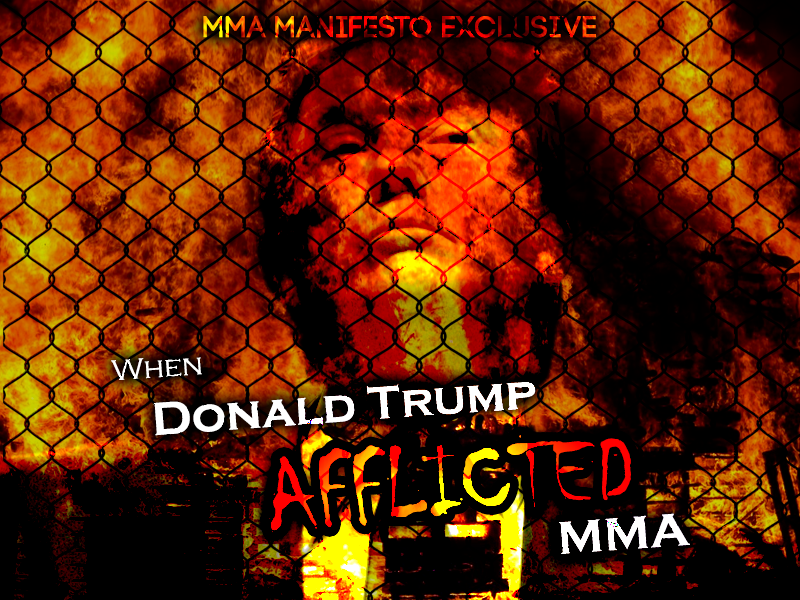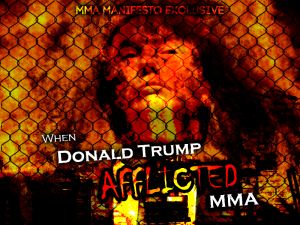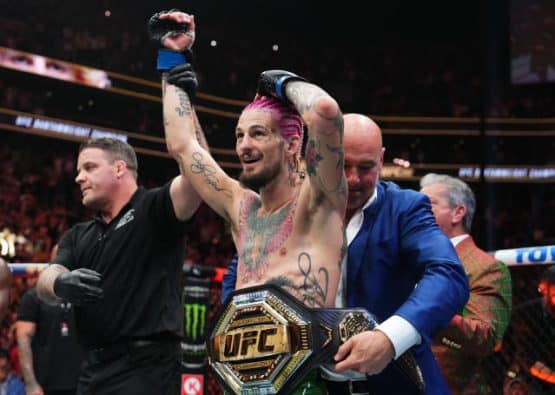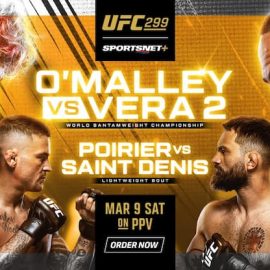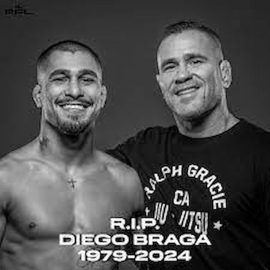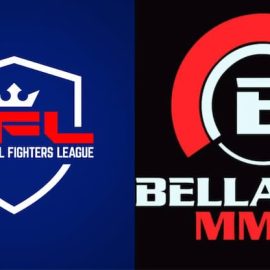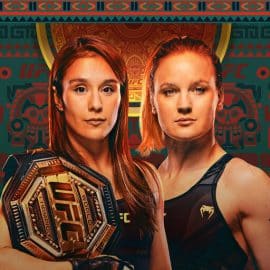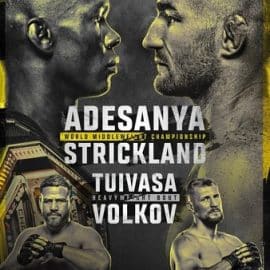It was 2008. The UFC had defeated its main competitor Pride FC the year before—buying out the Japanese operation, shutting it down, and absorbing some of Pride’s best fighters into their roster. As a result of the void, a lot of MMA promotions were born in the hopes of gaining market share in an industry that was dominated by a single business in the UFC.
Boxing promoter Gary Shaw backed Elite XC, and the company signed a landmark broadcast television deal with CBS in 2008—headlined by street fighter Kimbo Slice to surprising success. Kickboxing promoter Scott Coker founded Strikeforce: a San Jose-based MMA operation building its brand around the legendary Frank Shamrock, who was (and still is) on a permanent exile from the UFC after bad relations with UFC President Dana White, and the promotion eventually found a home on premium cable network Showtime in 2008. The Shamrock-headlined Strikeforce events, including co-promoted shows with Elite XC, were successful for all involved, and illustrated that there was indeed space for MMA brands to succeed outside of the UFC.
Meanwhile, the UFC was achieving record business developing its own superstars and breaking into new markets—some of which had rejected MMA as a sport in years prior. Tito Ortiz, Chuck Liddell, Randy Couture, Brock Lesnar, Rampage Jackson, Anderson Silva, and Georges St-Pierre were just some of the UFC’s homegrown superstars headlining pay-per-views and helping generate $271 million of revenue for the UFC in 2008. There was definitely money to be made in the mixed martial arts industry, and all that was needed were investors who wanted to take the risk of stealing business away from the UFC.
It didn’t seem to be an impossible task. White’s egomaniacal feuds with some of the most prominent stars in the sport ensured that there was a slew of established names who just needed a forum to ply their trade. Former UFC heavyweight kingpin Tim Sylvia wanted to fight (and get paid the same as) newcomer Brock Lesnar, who even with one career MMA bout, was making three times more than the former heavyweight champion in disclosed income. When the UFC balked, Sylvia left the promotion.
Another notable omission from the UFC’s roster was the invincible Fedor Emelianenko—a Russian annihilator who made his name in Pride by achieving a mythical winning streak and defeating some of the best heavyweights in the world using their own style against them. With Emelianenko and Sylvia both being long-time heavyweight champions of Pride and the UFC respectively, it was one of many cross-promotional dream fights that MMA fans fantasized about (more so to prove that Emelianenko was indeed the greatest heavyweight the sport had ever seen).
Unfortunately for the UFC, Emelianenko was managed by a Russian outfit called M-1 Global, which sought to grow its own brand solely on the merits of Emelianenko’s reputation, and allegedly, set unreasonable conditions (IE: building an arena in Russia) for the UFC to meet in order to get the famed Russian to sign with their company. Moreover, M-1 Global wanted to co-promote those Emelianenko-headlined UFC events. White thought this was absolutely ridiculous, and likewise to Sylvia, developed a perpetual grudge against Emelianenko and his manager Vadim Finkelchtein which lasts to this day.
This didn’t quite work for then-UFC Heavyweight Champion Randy Couture, who had defeated Sylvia to win the title and was looking for a big money “UFC vs. Pride” dream bout against Emelianenko. In late-2007, Couture infamously quit the UFC while champion, and left to seek the Emelianenko fight elsewhere. Unfortunately for Couture, UFC’s restrictive contract (recently called “draconian” by Emelianenko) was a major roadblock to Couture fighting anywhere outside of the UFC, and this began a year-long litigation battle which ultimately saw Couture end up back in the UFC in late-2008 to defend his championship against Lesnar. However, the possibility of Couture defeating the UFC in court and win his freedom was enough to motivate potential promoters to vie for the possibility of booking the much-coveted Emelianenko-Couture match. To them, it could’ve been the one bout to make their entire promotion in a single night, and boost them to UFC levels of popularity.
The rise of the UFC didn’t just open up opportunities for other MMA promotions, but for peripheral brands not organizing fights inside of a cage—e.g. apparel businesses. Tapout was among one of the first MMA clothing brands that began to flourish as the UFC gained mainstream success. However, the perceived image of MMA athletes somehow became intertwined with an American subculture of young men desperately needing to “represent”—usually with tattoos. The problem with tattoos, though, is that they’re typically covered or obscured by clothing. This opened up an opportunity for a company called Affliction Clothing to design shirts simulating full-torso tattoo designs, and use the open MMA fashion market as a quick way to spread their unique vision—achieving incredible success by sponsoring several top-name UFC fighters, and generating an estimated $100 million in revenue in 2008.
So we can see why Affliction became motivated to open up their own MMA promotion at the peak of their success.
- A thriving billion-dollar industry with only one real player and the allure of gaining a lot of market share in a short period of time.
- A successful base business with Affliction Clothing generating large amounts of revenue to provide a sizable amount of initial capital and to offside risk—maximizing the potential for success.
- An available talent base of unsigned fighters, including and especially established names who Dana White held grudges against and weren’t likely to fight for the UFC ever after.
- Perhaps most importantly, the potential to become one of the world’s most recognizable brands by using the synergy of MMA and apparel to succeed in both the sports and fashion industries.
Money, fame, success, power. The reasons for entering the MMA promotional business and competing with the UFC were clear. They just needed outside credibility to set them apart from the Elite XCs and Strikeforces of MMA. And they looked to find it with a New York-based billionaire named Donald John Trump.
Enter Trump
After decades of making a career as a real estate developer and flirting with certain areas of the entertainment business, Donald Trump was mainly known for two things in 2008: hosting NBC’s business-themed reality series “The Apprentice,” and licensing his name to pretty much any operation willing to offer him money or equity. Quality control certainly wasn’t something that deterred Trump from getting involved with otherwise (and allegedly) seedy businesses (including the now-infamous Trump University, and a multi-level marketing scheme selling video phones through a company called ACN).
Trump had sampled MMA in the past (as he did professional wrestling) by letting then-new UFC President Dana White hold UFC 30 and UFC 31 at the Trump Taj Mahal in New Jersey during a time when not a lot of venues were interested in UFC events due to MMA’s reputation as a “bloodsport.” This loyalty is something that White remembered all the way to Trump’s current US presidential campaign in 2016 when he endorsed him publicly at the Republican National Convention. Though, in 2008, there didn’t seem to be any loyalty between White and Trump when the latter “bought” a significant stake in Affliction Entertainment—the name of Affliction’s MMA company.
Questions about how much Trump invested in Affliction arose. Most assumed it was for pennies on the dollar just so Trump could make the claim he had his own money involved, and statements from Trump made it seem like he couldn’t care less if Affliction succeeded or failed—as if he was already compensated for licensing his name to the operation, and was now just on the media train because he was required to be.
“It’s financial. But it’s not a very big deal for me… When you build a billion-dollar building like I’m doing in Dubai, and a lot of other places, that’s a much bigger financial commitment.” – Donald Trump on Affliction Entertainment, 2008
Obviously, Trump lacked the commitment that White had when he was building the UFC into a global corporation in the 2000s, or even Trump’s northeast compatriot Vince McMahon, who built a billion-dollar professional wrestling empire in the 1980s and 1990s with the WWF while Trump was building his own conglomerate. But despite all of the rhetoric that Trump used in order to feign enthusiasm for Affliction, it was at least clear to the MMA audience that Trump was just a big name attached to the promotion solely for the sake of creating a splash in the New York market. Affliction Entertainment likewise affiliated with Oscar De La Hoya and his Golden Boy Promotions brand to generate buzz in the boxing realm.
When Affliction made it obvious they were getting into the MMA promotional business and were recruiting Couture, who was in exile from the UFC in early-2008 and was already connected to Affliction Clothing with a sub-brand called “Xtreme Couture,” the UFC banned Affliction Clothing from sponsoring their fighters—ending Affliction’s presence on UFC programming. Affliction then announced their first event, aptly titled “Affliction: Banned.” UFC responded by counter-programming the event with a free Spike TV card headlined by middleweight champion Anderson Silva. The war was on.
The UFC-Affliction War
“The UFC is threatened by us… I’m up for the challenge.” – Tom Atencio, Vice President of Affliction, 2008
- 265: Fedor Emelianenko vs. Tim Sylvia
- 265: Andrei Arlovski vs. Ben Rothwell
- 265: Josh Barnett vs. Pedro Rizzo
- 205: Renato Sobral vs. Mike Whitehead
- 185: Matt Lindland vs. Fabio Negao
- 145: Mark Hominick vs. Savant Young
- 265: Paul Buentello vs. Gary Goodridge (Prelim)
- 205: Antonio Rogerio Nogueira vs. Edwin Dewees (Prelim)
- 185: Vitor Belfort vs. Terry Martin (Prelim)
- 170: Mike Pyle vs. JJ Ambrose (Prelim)
The initial Affliction event was notable for how many big names they stacked onto a single card. Both Tim Sylvia and Andrei Arlovski were freshly released from the UFC but remained synonymous with UFC’s heavyweight division due to their long-reigning success in the years prior. Likewise with Fedor Emelianenko and Josh Barnett in Pride—the latter also a former UFC champion who had a longstanding feud with Dana White. Renato Sobral was just coming off a heralded run in the UFC’s light heavyweight division, including a big PPV main event challenging Chuck Liddell for his title at UFC 62 less than two years prior, but was released by a furious White after maliciously holding onto an anaconda choke for too long. Matt Lindland, who was still considered one of the best middleweights in the world, was another top fighter on the UFC’s blacklist for having worn a competing casino’s t-shirt as a sponsorship on a UFC broadcast—defying UFC co-owners Frank and Lorenzo Fertitta, who also co-owned Station Casinos as part of their family business. Most fighters on the card were established names, having been promoted by the UFC or Pride at one time or another, and were rewarded handsomely for it by Affliction.
So when the PPV numbers came in, Affliction played it close to the chest—hinting they would exceed 100,000 buys. However, the reported number since has been exactly 100,000, which considering a bad UFC PPV at the time still would’ve doubled that figure, was not the success Affliction needed to become a serious player in the MMA industry—especially after splurging an estimated $1 million for Emelianenko and $800,000 for Sylvia (not to mention, whatever it cost to have heavy metal band Megadeth perform live at the show to no effect on the audience nor the business of the event). Affliction had to learn from their first dive into the MMA business, and needed to do better if they wanted to continue promoting fights and not drown in the process.
Thus, Affliction booked a sequel to “Banned.” At their initial event, Emelianenko stunned Sylvia with a series of strikes and submitted him in 36 seconds. Arlovski and Barnett were also successful on the undercard with knockout wins. So next for Emelianenko was a fight against Sylvia’s rival and former UFC champion Andrei Arlovski.
The second event, titled “Affliction: Day of Reckoning” correspondingly did 90,000-100,000 buys, and showed diminishing returns despite another strong card. With all of the initial buzz, how could these well-booked cards backed by investors like Donald Trump and Oscar De La Hoya tank so miserably? It was becoming obvious that the perception of wealthy backers going all-in to defeat the UFC and become the leaders of the hip new MMA industry was merely that: a perception of success that didn’t yet exist… and was likely never going to.
After Emelianenko knocked out Arlovski in the first round at “Day of Reckoning,” Affliction was to come back for a third event booking Emelianenko against the next former UFC champion and fellow Pride competitor Josh Barnett. However, Barnett tested positive for anabolic steroids, and the California State Athletic Commission refused to license him. A last-minute scramble to find a replacement (rumored at the time to be Vitor Belfort) proved fruitless, and the event was cancelled.
At this point, it was becoming quite apparent that promoting MMA was a lot harder than it first seemed, and the Affliction Entertainment experiment was not working. Not only that, but the UFC banning Affliction sponsorships from their shows blocked Affliction’s original pathway to success, which was to appeal directly through the sizable MMA audience (of which the UFC had a virtual monopoly over) into the mainstream.
So not only did Affliction’s MMA project sink on its own, but the repercussions of getting into the promotional business had negative effects on their base operations. Affliction realized that they needed to re-establish their relationship with the UFC in order to save their clothing line, and that promoting MMA events at that scale so quickly was a fool’s quest and a major error in judgment.
On July 24, 2009, the day after Affliction’s originally-scheduled, but ultimately cancelled third event (which was to be titled “Affliction: Trilogy”), Affliction settled with the UFC by ceasing their MMA operations, relinquishing their video library to the UFC, and being allowed back as a sponsor at UFC events.
Donald Trump, The MMA Promoter
Though Trump played around with politics prior to his foray into MMA in 2008, none of us could’ve predicted a serious run all the way to winning the Republican nomination in 2016, and being reasonably close to actually becoming the President of the United States (prior to his recent scandals pushing the pendulum in Hillary Clinton’s favor). Trump’s hyperbole on the campaign trail this year is not unlike that of his manufactured enthusiasm for getting into the MMA business.
“If we make money, that’s great. I think we will. I think it will be successful… What I do is usually successful.” – Donald Trump on Affliction Entertainment, 2008
Of fellow Affliction Entertainment investor Oscar De La Hoya’s involvement, HBO Boxing commentator Larry Merchant claimed that De La Hoya was given $5 million to appear at Affliction’s MMA shows. It could only be assumed that Trump was given a similar deal to lend his name to the brand, and comparably appear at the shows as if he was a serious co-owner looking to build a realistic competitor to the UFC.
It begs the question that if promoting MMA was something that truly interested Trump, and something that he did spend his time and resources to develop, what could’ve been achieved? And how would the MMA industry have evolved if there was a major competitor to the UFC after Pride folded?
Not only did Trump watch Vince McMahon’s WrestleMania spectacles at the Trump Plaza in 1988 and 1989—both of which were built around the national sensation of American superhero Hulk Hogan—but at the same arena around the same time, Trump also hosted the Mike Tyson-Michael Spinks boxing bout during Tyson’s prime in 1988. One has to wonder if Trump, sitting ringside and always ambitious to expand his brand, ever fantasized about developing his own superstar to fill out his arenas on a regular basis and achieve success in the lucrative sports business. If so, could UFC outcast but the unanimously greatest fighter in the world (at the time) Fedor Emelianenko have been Trump’s megastar?
Perhaps an earlier failed foray in football deterred Trump from making the same mistake twice, but Trump did take a keen interest in investing into competitive beauty pageants (perhaps not surprising)—which are not unlike the business of combat sports with its television contracts, ad sales, and event production. Similar associations with cycling and golf have shown that although Trump has a passing curiosity for the business of sports, he hasn’t ever been able to go all-in after the disappointing USFL/New Jersey Generals debacle.
Ultimately, Trump’s legacy in MMA ends up being salvaged because of how insignificant Affliction Entertainment was in the grand scheme of things, and White endorsing Trump during his RNC speech in 2016 almost dismisses the UFC-Affliction war completely. Instead, with White still at the UFC helm, Trump will likely be much more remembered for supporting the UFC during an era when Senator John McCain was referring to the sport as “a form of human cockfighting,” and was having UFC events pulled from PPV broadcasts to kill the sport completely.
In this regard, Trump somehow winds up as a hero in this story—having had the courage (and foresight) to stand up for a sport that ultimately achieved mainstream success. What a strange world we live in.
Attributions
“Donald Trump” by Gage Skidmore is licensed under Creative Commons ShareAlike 2.0 Generic (Modified)
Add The Sports Daily to your Google News Feed!
